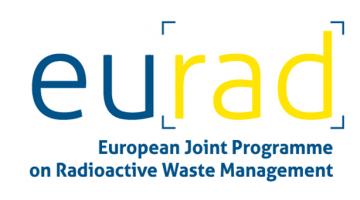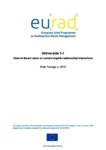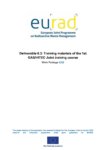CORI: Cement-organic-radionuclide interactions
CORI was an RD&D Work Package (WP) within EURAD. It aimed to improve understanding of the role of organics (either naturally occurring or introduced by the wastes) and their influence on radionuclide migration in cement-based environments.
Overview
CORI was selected for inclusion in the first phase of EURAD as it was relevant to Theme 4 “Geoscience to understand rock properties, radionuclide transport and long-term geological evolution” of the EURAD Roadmap.
Due to the potential degradation of organic matter, understanding their influence on radionuclide migration is particularly challenging in cementitious environments. Due to the importance of this subject in national programs, similar work to that addressed by this WP has previously been conducted (for instance, the meetings of the former TSWG in May 2013, Ghent, Belgium, leading to the CEBAMA project, or the extended discussion on CORI at the 6th IGD-TP Exchange Forum (2015) in London, UK). Over this period, partners were eager to join forces for a strong improvement in scientific understanding allowing assessing long term radionuclide mobility in organic rich cementitious waste disposal environments.
Objective
CORI aimed to develop an in-depth understanding of the interaction of cementitious materials with omnipresent organic matter and with radionuclides. Organic materials are present in some nuclear waste and as admixtures in cement-based materials, and can potentially influence the performance of a geological disposal system, especially in the context of low and intermediate level waste disposal. The potential accelerating effect of organic molecules on radionuclide migration is related to the formation of complexes in solution with some radionuclides of interest (actinides and lanthanides) which can (i) increase the radionuclide solubility and (ii) decrease the radionuclide sorption. CORI’s raison d’être was to quantify the organic release issues which can accelerate radionuclide migration in the context of the post-closure phase of geological repositories for ILW and LLW/VLLW, including surface/shallow disposal.
Closing words from WP Leader
CORI has finalized the experimental program, the joint final data evaluation and the assessment of potential future CORI impacts during Year 5. There are 10 publications from CORI published during the reporting period, i.e. relating to studies on (i) Radiolytic degradation of cellulosic materials in nuclear waste: effect of oxygen and absorbed dose, (ii) Effect of organics and cement degradation on 63Ni solubility in cement pore waters, (iii) Complexation of Eu(III) and Cm(III) by the Aminocarboxylates NTA, EDTA, and EGTA studied with NMR, TRLFS, and ITC,(iv) Influence of gluconate on the retention of Eu(III), Am(III), Th(IV), Pu(IV), and U(VI) by C-S-H (C/S = 0.8), (v) Uptake of Pu(IV) by hardened cement paste in the presence of gluconate at high and low ionic strengths, and (vi) Impact of the degradation leachate of the polyacrylonitrile-based material UP2W on the retention of Ni(II), Eu(III) and Pu(IV) by cement. CORI has successfully disseminated results in more than 35 conference contributions. A key event in CORI during the reporting period was the organization of the 6th International Workshop on Mechanisms and Modelling of Waste / Cement Interactions in connection to the CORI Annual WP Meeting. Both events were hosted by the Czech partners in CORI and held in late November 2023 in Prague. A Special Issue of Applied Geochemistry following this event is under preparation with input from CORI partners and support by Task 1. Several CORI contributions to the Migration conference in Nantes and contributions from CORI to the EURAD Annual Event in Bukarest were likewise a focus of activity. Special attention was given to the preparation of Deliverables and the final reporting in EURAD. The three KPIs defined for Year 5 in EURAD, one KPI in connection to organizing and hosting the conference in Prague mentioned below, have been reached. Considering the other KPIs, CORI has performed an impact evaluation during the final WP meeting in March 2024 and summarized the outcome in D3.5, which also includes a discussion of CORI-ICS interactions.
Considering the work performed in CORI, the strengths are first of all the plenty new experimental data derived for a wide selection of relevant systems and the significant advances in scientific process understanding. The high number of young researchers involved the dynamic dissemination (35 contributions to conferences during the reporting period) and the involvement in overarching EURAD activities are additional strengths. A weakness could be seen in the fact that CORI did not include modeling studies to complement/analyze the wet-chemistry studies, but this is also an opportunity for future projects more focused on modeling, like the RAMPEC WP in EURAD II. No unforeseen risks emerged during the reporting period.
Closing remarks. At the end of the present reporting period, the WP CORI has been finalized and is now closed. We report that the initially planned project aims were reached and the knowledge as well as experimental database in the investigated areas were clearly advanced beyond the initial state-of-the-art. CORI has been a success. CORI is proud of this positive outcome, especially considering that a significant part of the experimental work was performed under challenging conditions impacted by the COVID crisis. Results from CORI are publicly available within the combined Deliverable D3.6,7,8 (including detailed information on the experimental studies performed by the groups in the three RD&D Tasks) and Deliverable D3.5 (integrated Final Report with discussion on application to the Safety Case). Fundamental technical information on the topics covered in CORI is available in the SOTA D3.2 document.
CORI wants to acknowledge the often exceptional efforts performed by the CORI partners and the Task leaders within the experimental program. Many thanks likewise go to the CORI End User Members, colleagues from other WPs and ICS with whom CORI exchanged during EURAD and also the PMO and EURAD Coordination team who provided support and ensured excellent project management.









